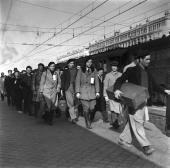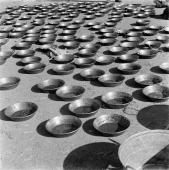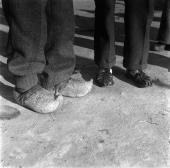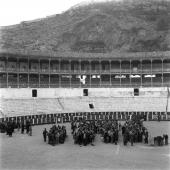This series of images represent a body of work in which Jacques Léonard (Paris, 1909 – L’Escala, 1994) documents the pace of thousands of young frenchmen trying to flee Nazism and join the Allied forces in the North of Africa. It is one of the very few records that have come out to light of this historic moment. This group of photographs illustrate a convoy of refugees, mostly french, that arrived in Malaga from different parts of Spain from where they would travel to freedom on December, 29th, 1943.
Jacques Léonard (Paris, 1909 – L’Escala, 1994), son of a horse dealer of Romani origin and the principal of a Paris fashion house, came late to the world of photography but was equipped with important professionals baggage related to image. He soon began working in the world of film on editing and production, and collaborated with various directors. He travelled all over the world before he arrived, in 1940, in Spain, in search of locations for a film about Christopher Columbus that was never made because of the war in Europe. Here he met the director general of cinematography who offered him the chance to work in various posts, and settled in Madrid.
In 1949, he moved to Barcelona with theatre impresario Arthur Kaps, becoming his right-hand man. Soon after arriving he met the humourist Robert Lamouret, whom he accompanied on a world tour as his secretary, traveling to England, Australia, Greece and Italy. When the tour ended in 1952, he settled in Barcelona where he fell in love with Rosario Amaya, a Roma woman who worked as an artist’s model. They married, and Jacques began to work as a freelance photographer.
Francesc Català-Roca provided him with contacts, and he contributed to various media: La Vanguardia, La Gaceta Ilustrada, Pomezia (the publication of the Bishopric of Barcelona) and Sant Jordi (the review of Barcelona Provincial Council), and he opened his own laboratory devoted to advertising photography.
In 1975, after the Roma neighbourhoods in Barcelona were broken up, he settled in La Mina. Due to health problems, he gave up photography and worked on Les quatre fers en l’air, a book about Roma culture, which was not published despite initial interest from Plon, a publishing house in Paris specialising in ethnology.
In 1991, by then with serious health issues, he moved to l’Escala, where he died in 1994. His legacy consists of 18000 negatives deposited by his children in the Barcelona Photographic Archive. They document various subjects, with almost 3000 devoted to Roma culture.
This exhibition is part of DOCfield Barcelona Documentary Photography Festival. More information at: www.docfieldbarcelona.org











